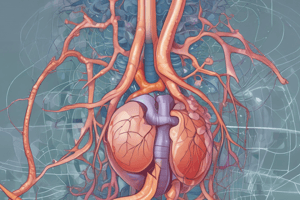Podcast
Questions and Answers
What is the effect of inhibiting the Na/Cl cotransporter in the distal convoluted tubule?
What is the effect of inhibiting the Na/Cl cotransporter in the distal convoluted tubule?
- Increase in calcium reabsorption
- Decrease in sodium-calcium exchange
- Increase in calcium excretion
- Decrease in sodium-calcium exchange at the basolateral membrane (correct)
Which diuretic is contraindicated in patients with hyperkalemia?
Which diuretic is contraindicated in patients with hyperkalemia?
- Potassium-sparing diuretic (correct)
- Loop diuretic
- Carbonic anhydrase inhibitor
- Thiazide diuretic
What is the duration of action of carbonic anhydrase inhibitors?
What is the duration of action of carbonic anhydrase inhibitors?
- 6-8 hours
- Around 10 hours (correct)
- 2-4 hours
- 10-12 hours
What is the mechanism of action of osmotics?
What is the mechanism of action of osmotics?
What is the potential adverse effect of Vasopressin V2-receptor antagonists?
What is the potential adverse effect of Vasopressin V2-receptor antagonists?
Which of the following substances is primarily secreted in the proximal tubule?
Which of the following substances is primarily secreted in the proximal tubule?
Which type of diuretic inhibits the Na/K/2Cl-cotransporter in the ascending loop of Henle?
Which type of diuretic inhibits the Na/K/2Cl-cotransporter in the ascending loop of Henle?
What is the effect of aldosterone on the collecting tubule and duct?
What is the effect of aldosterone on the collecting tubule and duct?
Which of the following diuretics has a short duration of action and a high ceiling effect?
Which of the following diuretics has a short duration of action and a high ceiling effect?
Which of the following substances is primarily reabsorbed in the descending loop of Henle?
Which of the following substances is primarily reabsorbed in the descending loop of Henle?
Flashcards are hidden until you start studying




